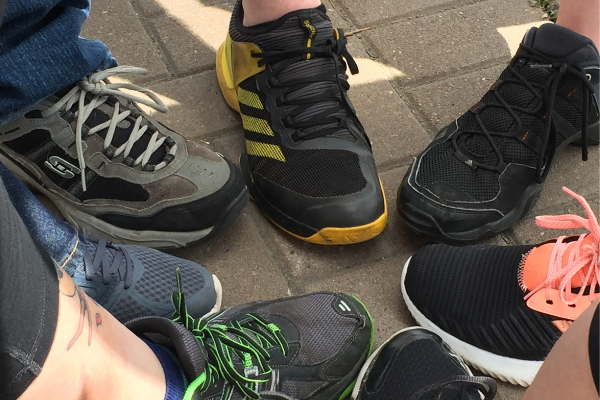
If you have a connective tissue condition, chances are you are probably having problems with your feet. Maybe your toes are annoyingly long, or your ankles hurt, or your arches are flat. Not to mention trying to find decent shoes—(dare I say attractive!). Many of these issues can contribute to balance problems as well. At different times, I have had experience with all of the above, and maybe you have, too. I asked Dr. Adam Bitterman, DO, orthopedic surgeon and foot and ankle specialist at Northwell Health Orthopaedic Institute and a member of the Foundation’s Professional Advisory Board, to give us some guidance. This article is not only about those tell-tale toes, but also about other foot and ankle problems that might interfere with our quality of life.
Problem Toes
Most people (approximately 70%), not only those with Marfan syndrome and related conditions, are probably wearing the wrong sized shoes, says Dr. Bitterman. And the problem is worse for those of us with connective tissue conditions, whose feet tend to be longer and also may be wider, especially at the toe, so shoes with a large enough “toe box” – the part around the toes — are key.
Dr. Bitterman explains that toe deformities in connective tissue conditions generally result from abnormal quality of the soft tissues. The toes may grow longer than normal (as sometimes do our fingers) and the connective tissue surrounding the toes may “pull” the joint out of proper alignment – creating hammertoes, for example. The problem is made even worse with shoes that are not the correct size: Toes get pressed against one another and a small bone spur of one toe can lean on another toe and cause a painful corn or a pressure sore. Being able to offload is key, and that can be done with “donut” toe pads or wider shoes that do not cause pressure of one toe onto another.
While surgical repairs are certainly possible, says Dr. Bitterman, including releasing the “pull” of the abnormal soft tissue, or even fusing the toe joints, he recommends trying to avoid procedures if possible. You can do this by consulting with specialized shoe stores in your area — perhaps with recommendations of a local foot and ankle specialist, such as a podiatrist or orthopaedic surgeon — and buying shoes that give your toes the room they need.
In addition, there are many non-prescription toe splints, toe braces, and padding devices that can be used for hammertoes, claw toes, and painful corns. You can find these in the foot section of your local pharmacy.
Arch problems
Connective tissue conditions can also cause flat feet because the arch has lost its soft tissue support. In addition to flatter feet, people with connective tissue conditions (and other people too) may develop painful lumps of “fascia” (tissue) at the bottom of the feet, a condition called “plantar fibromatosis,” which is a very close relative to “plantar fasciitis.” Helpful treatments include “stretching, stretching, stretching and then stretch some more,” says Dr. Bitterman, “especially of the muscles to the calf and leg (hamstrings).”
He suggests cushioning the bottom of the foot via gel heel cups or padded orthotics as excellent ways also help to reduce pain. You can also try night stretching splints and massage and/or physical therapy.
“A frozen bottle of water or ball on the bottom of your foot can help as well,” says Dr. Bitterman. “Most of the time, arch pain can be resolved without surgery.”
Weak ankles and ankle pain
This is similar to the problem above, says Dr. Bitterman. Stretching and strengthening are key to maintaining appropriately flexible lower extremity muscles. It is important to work with a professional physical therapist so that you don’t overstretch “floppy” connective tissue, while at the same time strengthening the muscles that support the feet and ankles.
“Lower extremity exercises and proprioception exercises with physical therapy, Pilates, yoga, or tai chi have been found to be extremely helpful and I encourage people to continue them formally and on their own,” says Dr. Bitterman. “Sometimes braces are necessary, but too much of a good thing can certainly cause harm.”
***
If you have medical questions related to the feet, please submit your question to our Help & Resource Center.

Roanne Weisman, MSW, has been writing for consumers and professionals in the areas of health, medicine, education, and science since 1985. (TheWriteWayToHealth.com.) Roanne has Marfan syndrome, as does her son, Ben Weisman, a Marfan Foundation Board member. The co-author of several award-winning trade health books with physicians, Roanne is a skilled “translator” of medical and scientific information. Her most recent book, In Sickness As In Health: Helping Couples Cope With the Complexities of Illness, is about the effects of serious injury and illness—including chronic conditions like Marfan Syndrome— on intimate relationships.
